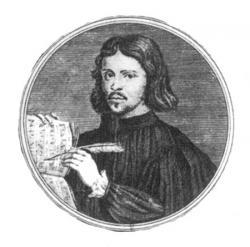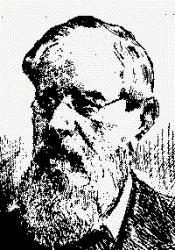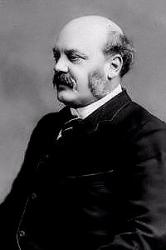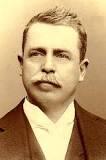Planning worship?
Check out our sister site, ZeteoSearch.org,
for 20+ additional resources related to your search.
- |
User Links
Person Results
Franklin L. Sheppard
1852 - 1930 Topics: Songs Suitable for Primary Composer of "[This is my Father's world]" in Children's Hymnal Franklin L. Sheppard (b. Philadelphia, PA, 1852; d. Germantown, PA, 1930) arranged the tune for Babcock's text and published it in the Presbyterian church school hymnal Alleluia (1915), edited by Sheppard (Babcock and Sheppard were friends).
After graduating from the University of Pennsylvania, Philadelphia, Sheppard entered the family foundry business in Baltimore, Maryland, in 1875. He was organist at Zion Episcopal Church and later was an elder and music director of the Second Presbyterian Church in Baltimore. President of the Presbyterian Board of Publications, Sheppard also served on the committee that prepared the Presbyterian Hymnal of 1911. In the history of hymnody he is remembered primarily for arranging the tune TERRA BEATA for “This Is My Father's World.”
Bert Polman
Franklin L. Sheppard
Katharine Lee Bates

1859 - 1929 Topics: Songs Suitable for Primary Author of "America, the Beautiful" in Children's Hymnal Katharine Lee Bates was born in Falmouth, Mass., August 12, 1859. Her father was a pastor in the Congregational Church; he died when she was an infant. Her mother moved the family to Wellesley. She received a B.A. (1880) and M.A. (1891) from Wellesley College. She taught high school from 1880-1885 and then was a professor of English literature at Wellesley. She wrote poetry, children's stories, textbooks and travel books. In the summer if 1893 when she was lecturing at Colorado College she went to the top of Pike's Peak. Inspired by the beauty of the view she wrote all four verses of "America the Beautiful" which was an instant hit when it was published. She had an intimate relationship with Katharine Coman, dean of Wellesley, who she lived with for 25 years, until Coman's death. "Yellow Clover: A Book of Remembrance" celebrates their love and partnership.She enjoyed traveling, the out of doors, reading and friends,
Dianne Shapiro from Woman's Who's who in America, 1914-1915 by John William Leonard, New York: The American Commonwealth Company and Harvard Square Library, Digital Library of Unitarian Universalist Biographies, History, Books and Media (http://harvardsquarelibrary.org/cambridge-harvard/katharine-lee-bates/) (accessed 7-4-2018
Katharine Lee Bates
Peter W. Dykema
Topics: Songs Suitable for Primary Descant of "[O beautiful for spacious skies]" in Children's Hymnal
Peter W. Dykema
Mary Mapes Dodge

1830 - 1905 Topics: Songs Suitable for Primary Author of "Can a Little Child, Like Me" in Children's Hymnal Mary Mapes Dodge is the often referred to as the "leader in juvenile literature" (Clarke, 1059), for she helped create and perpetuate the most widely circulated and read children's magazine during a time when American printing technology greatly improved and enabled the mass production of magazines and books. Dodge was born on January 26, 1831 in New York City. She grew up in a prominent family with two sisters. Her "own reminiscences were of 'a devoted father and mother and a happy childhood, a remarkably happy childhood, watched over with loving care'" (Gannon 3). Beginning in her early childhood, Dodge and her sisters were educated by a tutor in their home. Their father introduced them to a large variety of literature from the Bible to Shakespeare because at that time Dodge's father believed that children's literature was "a dreary wasteland" (Gannon 4). Dodge's early exposure to literature enabled her to develop a gift and appreciation for art, music, and writing. In her teenage years, Dodge could skillfully write and she assisted her father with his writings for pamphlets.
In 1851 Mary celebrated her marriage to William Dodge, and within the next 4 years, she gave birth to two sons, James and Harrington. The Dodge family confronted several hardships throughout their life together. In 1857, William faced serious financial difficulties concerning debts and the destruction of the company he worked for. During that same year, at the age of six, their son James was diagnosed with a fatal sinus disease. The effect of these disastrous events caused William to leave his family in 1858. He left for a walk from which he never returned. A month after his disappearance his body was found dead from an apparent drowning.
After the death of her husband, Mary was left in a bad financial position and with two sons to raise on her own. At this time, Mary "resolved 'to take up her life again in the old spirit of rejoicing; to rear and educate her boys as their father would have done; to do a man's work with the persistent application and faithfulness of a man, to gain a man's pay, yet to leave herself freedom and freshness to enter into all her children's interests and pursuits as their comrade and friend" (Gannon 7). Mary would not allow the unfortunate events of her husband's death and financial difficulty stand in her way from educating her sons and providing them with the life they deserved. In addition to educating her sons, she began writing and editing in 1859. Mary worked with her father to publish two magazines, the Working Farmer and the United States Journal. The editorial work she used for these magazines helped to shape her writing skills, which she later applied to edit the most successful children's magazine of her time.
Some of Mary's early writings before the publication of St. Nicholas include The Irvington Stories (1864) and Hans Brinker (1865). Hans Brinker is by far Dodge's most well known story, for it was published in several languages all over the world and this classic was considered "the best and most faithful juvenile story" (Clarke 1063). Four years after the publication and success of Hans Brinker, Dodge began working for a newspaper known as Hearth and Home." Dodge worked on the juvenile and household departments under the editorship of Harriet Beecher Stowe. Roswell Smith, one of the founders of the children's magazine Scribner's Monthly, observed Dodge's work at Hearth and Home. Smith considered Dodge for the editor of his newly created children's magazine, St. Nicholas, named for the patron saint for children. Dodge faced a difficult decision because she wanted to pursue novel writing and other challenging fields, but her heart remained with children. "Many gifted men and women were writing novels; no one was doing all that could be done--ought to be done--for the boys and girls" (Clarke 1063), and thus Dodge accepted the position of editor for St. Nicholas.
Dodge's goal for her children's magazine was to create literature that inspired and interested children. In 1873 she anonymously wrote for Scribner's Monthly,"a successful children's magazine "must not be a milk-and-water variety of the periodical for adults. In fact, it needs to be stronger, truer, bolder, more uncompromising than the other; its cheer must be the cheer of the bird-song; it must mean freshness and heartiness, life and joy" (Clarke 1063). Mary clearly illustrates here her intention for the path St. Nicholas. Mary hoped to portray the traditional values of society, to educate children, to provide enjoyable entertainment, and to prepare them for "life as it is" (Kelly 380).
Dodge took careful consideration for the layout of her magazine so she could fulfill her goals for a successful children's magazine. Two important obstacles confronted Dodge when she considered the type of articles to include in her magazine. The first problem she faced was how to entice her readers and maintain their attention. Dodge's technique to overcome this problem was the use of "regular departments" and "reader involvement" (Gordon, 380). The most famous regular department found in her magazine was 'Jack-in-the-Pulpit'. 'Jack-in-the-Pulpit' was "the inimitably wise and witty little preacher whose tiny discourses of the keenest sense and most inspiriting nonsense, . . . were a feast for the mind and souls of young folks every month" (Clarke 1065). Jack was a maternal type character that reflected Dodge's own personality. Dodge hoped to instill value and morals into the children without directly preaching to them. Jack provided an advantageous resource for accomplishing this goal because he was witty, humorous, and sincere. The children reading the story could easily identify with Jack's "preachings" and accept them because they were not directly aimed at the reader. In addition, Dodge added two more characters, Deacon Green and Little Schoolma'am, to provide authority figures and the introduction of new and interesting knowledge for the readers.
The second technique Dodge employed for her periodical was reader involvement. Dodge included two features, "The Puzzle Box" and "The Letter-Box." "The Puzzle Box" provided entertainment for the readers through riddles or games. The answers to these games, however, were not included in the issue of the magazine. Readers had to send their answers to the publisher for judging, and only then could they find out the true answers. "The Letter-Box" included letters written to Dodge from the readers. Publication for readers was not only included in this section, but Dodge also encouraged children to contribute their own literature to the magazine.
St. Nicholas became one the most successful magazines for children during the second half of the nineteenth century. Circulation increased to almost 70,000 children all over the U.S. The success of this periodical can be attributed to Dodge's dedication and the many contributors. Dodge's persistence in finding extraordinary talents such as Louisa May Alcott, Rudyard Kipling, President Theodore Roosevelt, F. Scott Fitzgerald, and Sarah Orne Jewett provided a variety of intellectual and artistic material for children every month. St. Nicholas' began in 1873 and continued for the next 30 years with a few publications after Dodge's death in 1905. Dodges dedication to children is clearly evident in the hard work she devoted to this magazine. Dodge is an inspirational women who set goals people thought impossible, but ones she was able to achieve. In a memoir written after Dodge's death in a St. Nicholas publication, Dodge is described as a woman who put her heart into her work and achieved the goals she put forth. "What she attempted, she performed. There was no emergency, great or small, to which she was not equal; there was no Hill of Difficulty" (Clarke 1064). She was a woman to be truly admired, for her thirty years of work dedicated to children has influenced the world of periodicals ever since.
--www.facstaff.bucknell.edu/gcarr/ (excerpts)
Mary Mapes Dodge
D. B. Towner

1850 - 1919 Person Name: D. B. T. Topics: Songs Suitable for Primary Author of "Giving Thanks" in Children's Hymnal Used pseudonyms Robert Beverly, T. R. Bowden
==============================
Towner, Daniel B. (Rome, Pennsylvania, 1850--1919). Attended grade school in Rome, Penn. when P.P. Bliss was teacher. Later majored in music, joined D.L. Moody, and in 1893 became head of the music department at Moody Bible Institute. Author of more than 2,000 songs.
--Paul Milburn, DNAH Archives
D. B. Towner
Thomas Tallis

1505 - 1585 Topics: Songs Suitable for Primary Composer of "[Our heavenly Father gives us gifts]" in Children's Hymnal Thomas Tallis (b. Leicestershire [?], England, c. 1505; d. Greenwich, Kent, England 1585) was one of the few Tudor musicians who served during the reigns of Henry VIII: Edward VI, Mary, and Elizabeth I and managed to remain in the good favor of both Catholic and Protestant monarchs. He was court organist and composer from 1543 until his death, composing music for Roman Catholic masses and Anglican liturgies (depending on the monarch). With William Byrd, Tallis also enjoyed a long-term monopoly on music printing. Prior to his court connections Tallis had served at Waltham Abbey and Canterbury Cathedral. He composed mostly church music, including Latin motets, English anthems, settings of the liturgy, magnificats, and two sets of lamentations. His most extensive contrapuntal work was the choral composition, "Spem in alium," a work in forty parts for eight five-voice choirs. He also provided nine modal psalm tunes for Matthew Parker's Psalter (c. 1561).
Bert Polman
Thomas Tallis
John Baptiste Calkin

1827 - 1905 Person Name: J. Baptiste Calkin Topics: Songs Suitable for Primary Composer of "[I heard the bells on Christmas day]" in Children's Hymnal John Baptiste Calkin United Kingdom 1827-1905. Born in London, he was reared in a musical atmosphere. Studying music under his father, and with three brothers, he became a composer, organist, and music teacher. At 19, he was appointed organist, precenter, and choirmaster at St. Columbia's College, Dublin, Ireland, 1846 to 1853. From 1853 to 1863 we was organist and choirmaster at Woburn Chapel, London. From 1863 to 1868, he was organist of Camden Road Chapel. From 1870 to 1884 he was organist at St. Thomas's Church, Camden Town. In 1883 he became professor at Guildhall School of Music and concentrated on teaching and composing. He was also a professor of music and on the council of Trinity College, London, and a member of the Philharmonic Society (1862). In 1893 he was a fellow of the College of Organists. John and wife, Victoire, had four sons, each following a musical carer. He wrote much music for organ and scored string arrangements, sonatas, duos, etc. He died at Hornsey Rise Gardens.
John Perry
John Baptiste Calkin
A. L. Peace

1844 - 1912 Person Name: Albert L. Peace Topics: Songs Suitable for Primary Composer of "[God listens when the children pray]" in Children's Hymnal Albert Lister Peace DMus United Kingdom 1844-1912. Born at Huddersfield, Yorkshire, England, son of a warehouseman and woolstapler, he was extremely gifted as a musician, largely self-taught, playing the organ at Holmfirth Parish Church near Huddersfield at age nine. He married Margaret Martin Steel Gilchrist, and they had three children: Lister, Archibald, and Margaret. In 1865 he was appointed organist of Trinity Congregational Church in Glasgow, Scotland. He obtained his doctorate degree from the University of Oxford in 1875. He became organist at Glasgow Cathedral in 1879. In 1897 he succeeded William Best as organist at St George’s Hall, Liverpool. In later years he was in much demand to play the organ in recitals. He did so at Canterbury Cathedral (1886), Victoria Hall, Hanley, Stoke-on-Trent (1888), and Newcastle Cathedral (1891). He composed orchestrations, sonatas, cantatas, and concert and church service anthems. He was an arranger, author, and editor. He died at Blundelsands, Liverpool, England.
John Perry
A. L. Peace
Melchior Vulpius
1570 - 1615 Topics: Songs Suitable for Primary Arranged from of "[Our new life is beginning]" in Children's Hymnal Born into a poor family named Fuchs, Melchior Vulpius (b. Wasungen, Henneberg, Germany, c. 1570; d. Weimar, Germany, 1615) had only limited educational opportunities and did not attend the university. He taught Latin in the school in Schleusingen, where he Latinized his surname, and from 1596 until his death served as a Lutheran cantor and teacher in Weimar. A distinguished composer, Vulpius wrote a St. Matthew Passion (1613), nearly two hundred motets in German and Latin, and over four hundred hymn tunes, many of which became popular in Lutheran churches, and some of which introduced the lively Italian balletto rhythms into the German hymn tunes. His music was published in Cantiones Sacrae (1602, 1604), Kirchengesangund Geistliche Lieder (1604, enlarged as Ein schon geistlich Gesanglmch, 1609), and posthumously in Cantionale Sacrum (1646).
Bert Polman
Melchior Vulpius
Samuel A. Ward

1848 - 1903 Topics: Songs Suitable for Primary Composer of "[O beautiful for spacious skies]" in Children's Hymnal
Samuel A. Ward


 My Starred Hymns
My Starred Hymns


